There’s an old adage in cooking that one eats with their eyes first, i.e., that the visual presentation of something has an impact that influences the perception of a plate of food. For some folk that’s more pronounced than others. I’ve sat at meals with absolutely wretched food listening to others at the table carry on about how beautiful each dish is and devouring them with gusto. I’ve even asked the question and basically gotten back, “yeah, maybe it’s not the best food in the world but did you see how gorgeous it was?” And, there’s the reverse, the camp that I tend to fall into, where the taste is all important. Truthfully, when I eat out, I don’t care that much about how something looks as long as it tastes good. It’s not that I’m oblivious, it’s just not my focus. Neither is the right way to approach food, neither is the wrong way, they’re just different. But, there’s no question that both the visual and the gustatory, for most people, have an influence (along with smell, obviously, and even texture and sound).
So it is that often, the first night of each week’s dinners (actually every night, but the first night is, perhaps, a trifle more “key”), there will be things that I note, or that guests note, that reshape the dinners to come. Most of the time that’s presentation – and I watch how people react to each plate when it’s placed in front of them and look for clues to what does and doesn’t seem to work. Sometimes it’s flavor, though usually I’ve worked on that experimenting around enough that I’m happy with how something tastes. Still, an off-hand or specific comment made might change slightly the way I’m thinking about a dish. After all I have my own tastebuds, and if the majority of people at the table seem to have the same reaction to something, I ought to be paying attention, no? Food Arts magazine, a trade magazine for high-end chefs, had (has?) a monthly column called “What do they know?” that was all about dishes that the featured chef of the month was convinced were going to be hits on their menus and that their customers just hated or wouldn’t order, for one reason or another. It was instructive….
So today’s going to be a bit visual, in writing up last week’s dinners – and I’m delighted to take input from readers as well if you spot something or disagree with me on how this went.
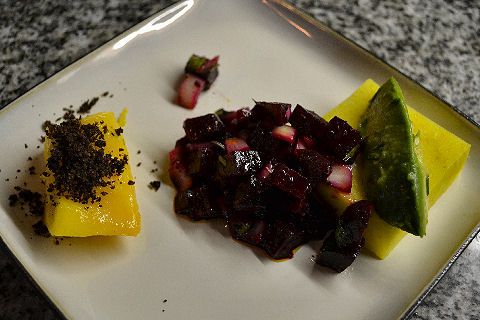
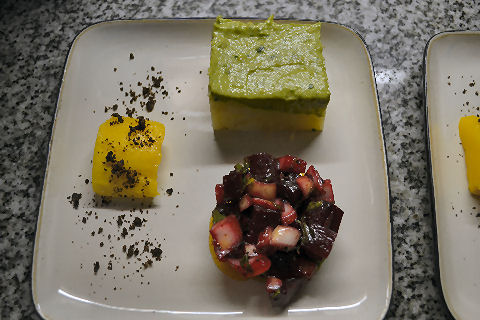
I’ve gotten raves about the taste on our new roasted beet salad causa. It’s a relatively simple fusion of two ideas – the classic Peruvian causa, a mashed potato dish that’s flavored with lemon, olive oil and ají amarillo. If you want to go back and look at what a real, traditional home cooking version is, along with recipe, check out this wayyy back version. And I’ve made many a version since with various toppings. The beet salad comes from one of our Syrian dinners from back during our “theme” days. Putting the two together just clicked one day – all the flavors work. And I was looking for something interesting to do with the black olive powder I’ve been playing around with and somewhere online I’d run across a mango and black olive salsa, so I tried the combination of the two together and, it worked. In terms of flavor, there’s no difference between the two dishes above, but visually, I think most folk would find the second plate more appealing.
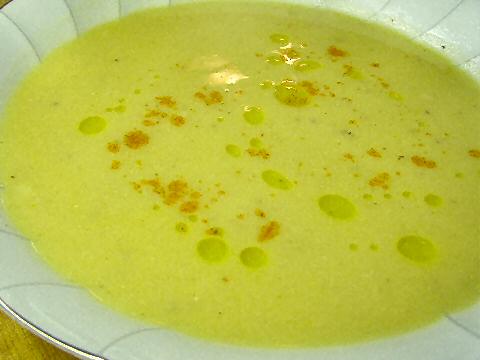
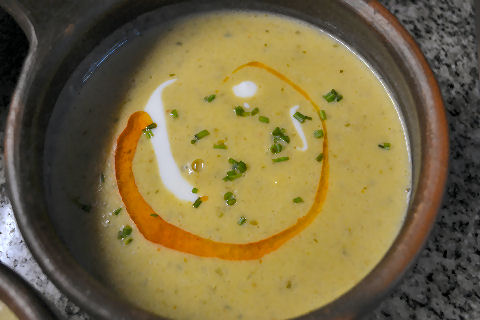
The first time I made what has become our hit “hummus soup”, it was as a fairly light soup based more on the tahini flavor, for a Greek themed meal about five years ago. The ingredients haven’t really changed – a minor change from the smoked Turkish urfa biber pepper to a smoked red Aleppo chili from Syria (though I still sometimes use the former as well), but the proportions have, and the chickpeas and potato play a bigger role, giving us a thicker, heartier soup. The simple olive oil drizzle and sprinkle of paprika has been replaced by a smoked paprika oil, I’ve added in a little swirl of salted yogurt, and some chopped chives. But the whole presentation of the dish changes with those simple fixes, no?
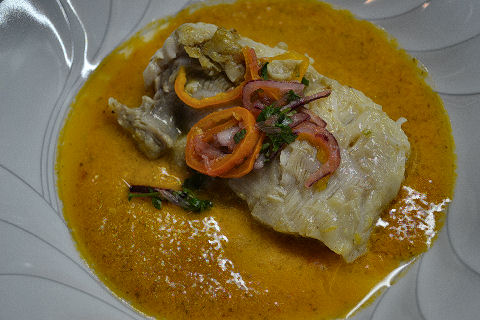
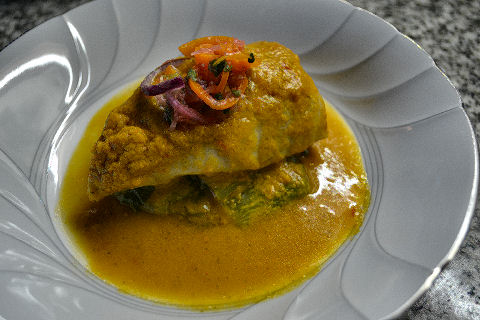
Awhile back I’d presented a dish that I liked but that didn’t go over as well as I’d hoped – it got a lot of mixed reaction. Albacore tuna poached in olive oil that was flavored with grapefruit, garlic and thyme. Most of the negative response tended towards its accompaniments – several folk didn’t like the wheatberries, a few thought the salsa verde was overpowering, and it was just a dish I stuck in the back of my mind to be played with at another time. Interestingly, everyone seemed to like the tuna itself with the grapefruit flavor infused into it. So I brought that component back, once again poaching the tuna the same way, but this time serving it over a light and fresh tomato and cilantro sauce, and topped with a little salad of red onions, yellow chilies, grapefruit segment dice, and cilantro. And it kinda sorta worked, but on the first night last week a couple of people thought the grapefruit rind flavor was too strong and that the sauce felt like an afterthought, plus it was missing something vegetable or starch. I thought about going with a completely different dish for the rest of the week, but then it occurred to me that I could poach the fish in the sauce itself, melding them together better, and simply added the grapefruit rind to the sauce, where it gave only a hint of that bitterness, but added a really appealing citrus note to it, and then slipped the fish into it to cook through. Kept the same salad atop, and added some escarole sauteed in olive oil with the garlic and thyme underneath – all the flavors preserved, but a different cooking method and presentation that completely changed the dish. With the exception of one person who I’ve heard from who insists the fish wasn’t remotely fresh (it was – I picked the fish out myself, watched it being filleted and then cut it into sections myself, each morning of last week) and refused to eat it, everyone else, including us, seemed to eat it and enjoy it just fine.
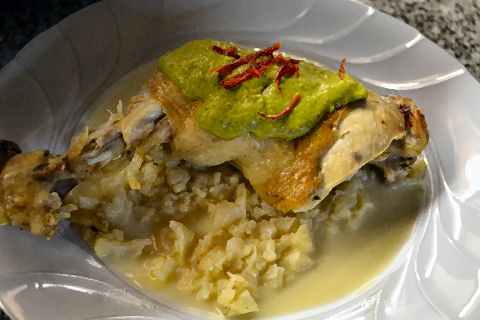
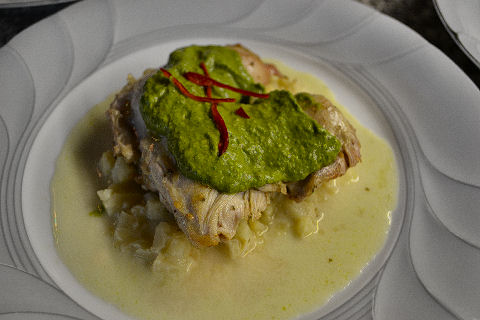
This one’s interesting for me because it requires sacrificing a certain amount of flavor for the presentation. I made roast chicken, following the Jonathan Waxman method I’ve presented before for a whole chicken, here just using thigh-drumstick quarters. It produces brilliant roast chicken. And I was thinking of pairing it with cauliflower, a combo I’ve made different versions of in the past, from fried cauliflower to toasted ravioli to giardiniera. I’ve been playing around with vegetable “risottos” – no rice used, but the vegetable chopped up finely to the size of rice, more or less, and then cooked in the same way – a little onion and garlic in oil first, then the vegetable added and well coated with the flavored oil, then adding white wine and cooking to absorb, and then ladling in chicken stock, a little at a time, until getting the texture just al dente, and finally, adding in some cream cheese (let’s face it, the vegetables aren’t going to develop that starch-creamy texture that arborio or carnaroli rice does). So I served a chicken quarter over the cauliflower “risotto” and topped with with a salsa verde. And then watched as everyone kind of toyed with the chicken, cut off a few bites, and then ate the cauliflower. And a couple of people said, more or less, “it’s delicious, but just too hard to eat it this way, you can’t really pick it up with the sauce and the creamy cauliflower, and cutting it off the bone is a pain”. So, the rest of the week I deboned the quarters and then pan roasted them – but, that removes all that flavor from roasting on the bone, and there’s no pretty way to keep the skin on and get it nice and crisp, it just falls off and gets all raggedy. I suppose I could have cooked the skin separately to make some crisp shards, or something of that sort, but in the end, just went with boneless, skinless chicken thigh-drumsticks. The rest of the dish is the same. No question it was easier to eat, and doesn’t look as unwieldy, and everyone pretty much finished it off the rest of the nights whereas the first night they’d left half the chicken on the bone, but for me, I’d have rathered the on the bone version. But that’s me. Strangely, the same person who thought the fish wasn’t fresh though the chicken was bland and inedible, though since everyone around her finished their plates off and near licked them clean, I have to think it was all just her. We’ll see if other commentary comes in.
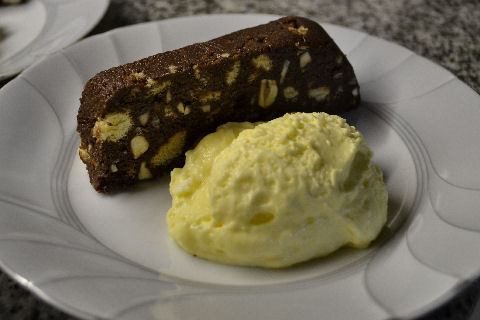

This one was actually a forgetful error on my part. The dessert, a gianduja pudding that I’ve made before, accompanied by a limoncello mousse. A bit rich and I wanted to cut it with something acidic, so I’d gotten some fresh blackberries and cooked them quickly in a little sugar syrup. The first night I simply forgot about them and apologies to those who didn’t get their blackberries. Everyone seemed to like it, but a couple of people groaned that it was all just too rich at that point. Mea culpa. And, it looks prettier with the blackberries on it. Maybe I still should have gone with the grating of chocolate over it all like the previous time around. And, I’m thinking, maybe just leaving the blackberries fresh without the dunking into hot sugar syrup – I’m not sure on that one, it just seems too much of a jarring contrast.
We live and learn. I’ve been asked many times if, given that dishes evolve, wouldn’t it be better to always come the last night of each week? I suppose in some ways, that could be true, and this little exercise may make that case (although I stand by that other than presentation, the chicken dish was better the first night even if more popular the rest of them). But, well, it’s impossible for everyone to always come last, it’s just the nature of dining out. And by the way, this is true about any restaurant you’ve ever gone to. Chefs are constantly tweaking things, sometimes better, sometimes not (I could do a whole post on dishes I’ve changed that were better the way they started out than the way they ended up, and any chef could).
I think the visual aspect of a dish is more important with the first dish you eat, the starter. It sets you up for entering into the meal. The second picture of the causa and beef salad is definitely more pleasing. It also sounds delicious, which helps!
In a main dish I think flavour is more important than presentation. I would prefer the first chicken dish to the second if the flavour were superior and anyone who can’t cut their chicken off the bone should stick to Gerber’s baby food.
With dessert, I think presentation comes into play again. The second dessert looks more balanced on the plate, whatever the flavour, and, if I saw both sitting on a buffet, I would choose the second.
That idea of vegetable risotto is brilliant and something I am going to try.
Thanks, as always, for your thoughts Frances. I think I’m with you on all that. I also think there are just folk out there who want every single plate to look beautiful, and really don’t care about the taste. I’ve just encountered it too often for it not to be a decent sized segment of the population. I can appreciate the desire for pretty plating, it’s just more important to me personally how things taste.
[…] We started off with prawn ceviche on a bed of spiced pear and cucumber, followed up with our hummus inspired soup, and at the end of dinner our four-layer chocolate torte, with one change – instead of the […]
[…] causa, which, for the most part, the last time I was playing with it I was looking at a sort of deconstructed presentation. While pretty, and definitely highlighting the elements individually, I have to admit that […]